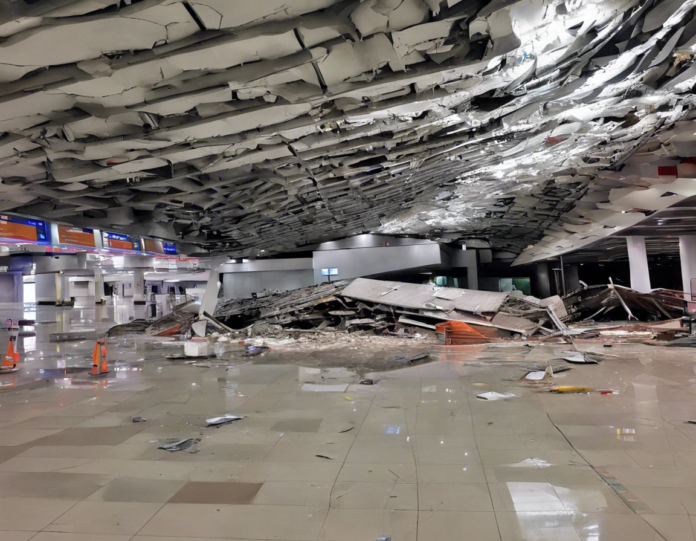In recent news, the Guwahati Airport in the Indian state of Assam came under scrutiny when a portion of the ceiling collapsed, raising serious safety concerns. The incident, which occurred on [date], highlights the importance of robust infrastructure maintenance and safety protocols in public facilities. The collapse not only disrupted airport operations but also raised questions about the overall safety standards in place.
Background and Incident
The Guwahati Airport, also known as Lokpriya Gopinath Bordoloi International Airport, serves as a crucial hub in the northeastern region of India. The airport handles a significant volume of domestic and international flights, connecting the region to major cities across the country and beyond.
The ceiling collapse incident occurred in a specific section of the airport terminal, leading to concerns about the structural integrity of the infrastructure. While there were no reported injuries, the incident sparked a broader discussion on the maintenance practices and oversight of public infrastructure projects.
Importance of Infrastructure Maintenance
Infrastructure maintenance is a critical aspect of ensuring the safety and longevity of public facilities. Regular inspections, timely repairs, and adherence to building codes are essential to prevent such incidents from occurring. Neglecting maintenance can lead to structural weaknesses, putting the safety of occupants and visitors at risk.
Proper maintenance not only mitigates safety hazards but also contributes to the overall functionality and aesthetics of infrastructure. Regular upkeep can identify potential issues early on, allowing for prompt intervention and preventive measures. It is essential for authorities and stakeholders to invest in sustainable maintenance practices to uphold the integrity of public spaces.
Safety Protocols and Regulations
Safety protocols and regulations play a pivotal role in ensuring the security of individuals in public spaces. Adhering to established guidelines and standards is crucial for architects, engineers, and contractors involved in the design and construction of infrastructure projects. Regulatory bodies enforce safety measures to uphold public safety and hold accountable those responsible for lapses in compliance.
Regular inspections, audits, and certifications are key components of maintaining safety standards in public facilities. These measures help identify potential risks, structural deficiencies, and compliance issues that require immediate attention. Additionally, training and awareness programs can educate stakeholders about safety protocols and best practices in infrastructure maintenance.
Addressing Safety Concerns
In the aftermath of the Guwahati Airport ceiling collapse, authorities have initiated investigations to determine the root cause of the incident. Identifying the factors that led to the structural failure is essential for implementing corrective measures and preventing similar occurrences in the future. Transparency in the investigative process and accountability for negligence are critical for restoring public trust in the safety of the airport.
Furthermore, reconstruction efforts must prioritize safety standards and quality assurance to prevent any compromise in the structural integrity of the renovated section. Engaging qualified professionals, conducting thorough assessments, and adhering to best practices in construction are imperative for ensuring the long-term safety of the airport terminal.
Future Outlook
The Guwahati Airport ceiling collapse serves as a stark reminder of the importance of prioritizing safety in infrastructure development and maintenance. It underscores the need for robust oversight, stringent regulations, and effective enforcement mechanisms to safeguard public spaces. Addressing safety concerns in a timely and proactive manner is fundamental to instilling confidence among travelers, employees, and the general public.
As India continues to witness rapid urbanization and infrastructure expansion, the emphasis on safety, sustainability, and resilience must remain at the forefront of development initiatives. Investing in quality infrastructure, integrating innovative technologies, and fostering a culture of safety consciousness are key strategies for building a secure and reliable built environment for all.
FAQs:
1. What caused the ceiling collapse at Guwahati Airport?
The specific cause of the ceiling collapse is under investigation, but factors such as structural weaknesses, poor maintenance, or design flaws could be potential reasons.
2. Were there any injuries reported during the incident?
Fortunately, there were no reported injuries resulting from the ceiling collapse at Guwahati Airport.
3. How often should infrastructure undergo maintenance inspections?
Infrastructure should undergo regular maintenance inspections as per established schedules, typically ranging from quarterly to annually, depending on the facility’s age and usage.
4. Who is responsible for ensuring safety standards in public infrastructure projects?
Various stakeholders, including government agencies, regulatory bodies, architects, engineers, contractors, and maintenance personnel, share the responsibility for ensuring safety standards in public infrastructure projects.
5. How can the public contribute to identifying safety hazards in public spaces?
The public can contribute to identifying safety hazards by reporting any concerns or observations to the relevant authorities, such as maintenance issues, damaged structures, or potential risks in public spaces.
6. What measures can be taken to prevent future incidents of infrastructure failure?
Preventive measures such as regular inspections, timely repairs, adherence to safety regulations, quality construction practices, and stakeholder accountability can help prevent future incidents of infrastructure failure.
7. How can transparency and communication be improved during infrastructure incidents?
Enhancing transparency through timely updates, public communication, detailed reports on investigations, and engaging with stakeholders can improve trust and transparency during infrastructure incidents.
8. What role does public awareness play in ensuring safety in public infrastructure?
Public awareness is crucial in creating a safety-conscious culture, promoting adherence to regulations, reporting safety concerns, and advocating for accountability in public infrastructure projects.
9. How can technology be leveraged to enhance infrastructure safety and maintenance?
Technological solutions such as sensors for monitoring structural health, predictive maintenance tools, data analytics for risk assessment, and digital platforms for reporting safety issues can enhance infrastructure safety and maintenance practices.
10. What are the long-term implications of safety lapses in public infrastructure?
Safety lapses in public infrastructure can have severe consequences, including injury or loss of life, damage to property, disruptions in services, legal liabilities, reputational harm, and a loss of public trust in authorities and infrastructure providers.




















